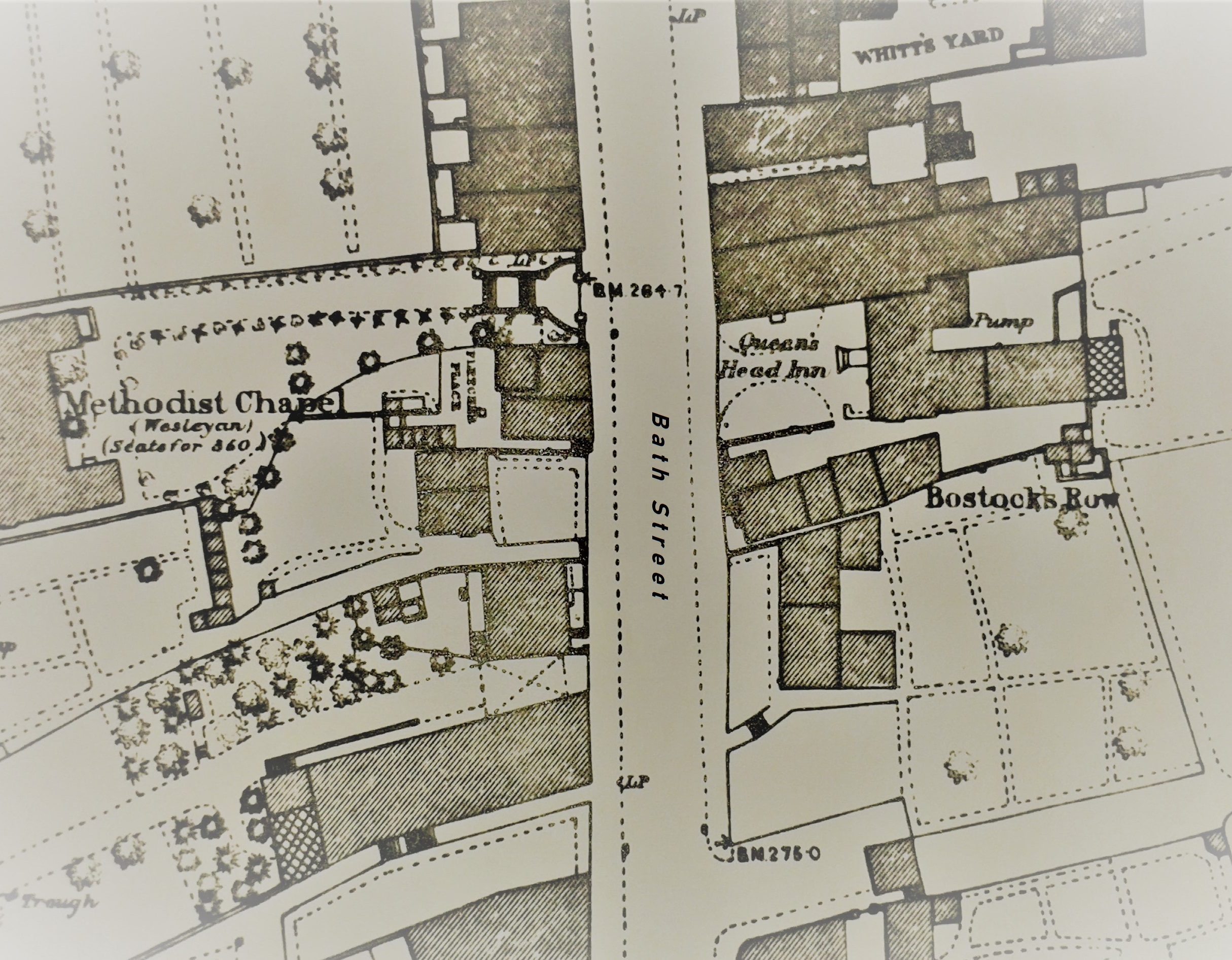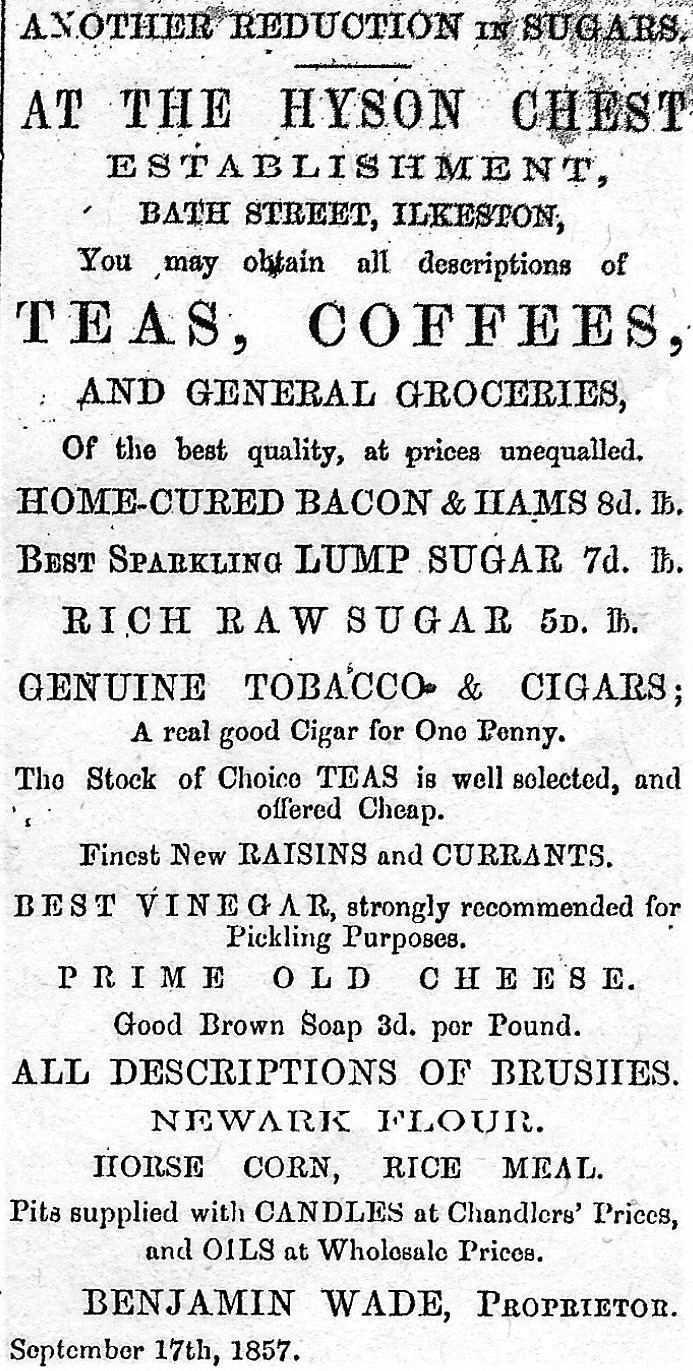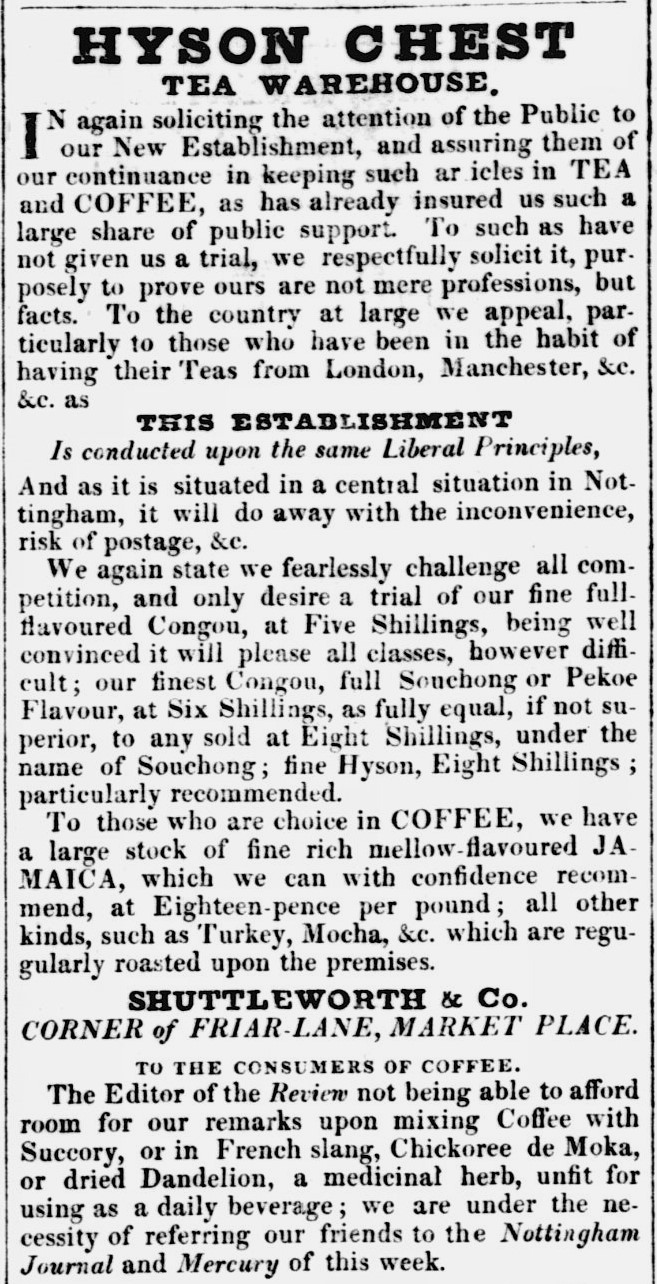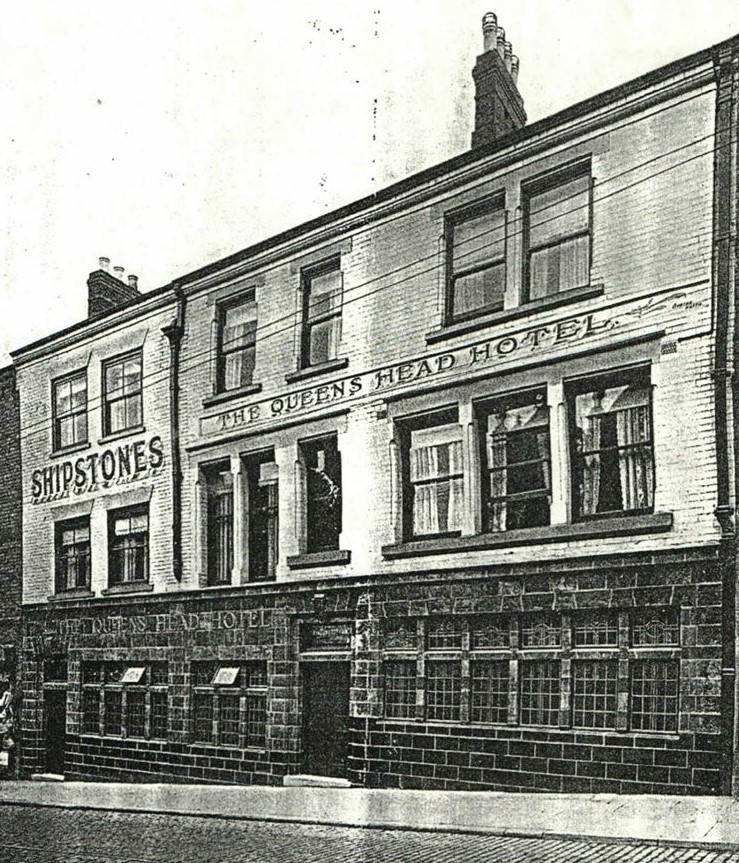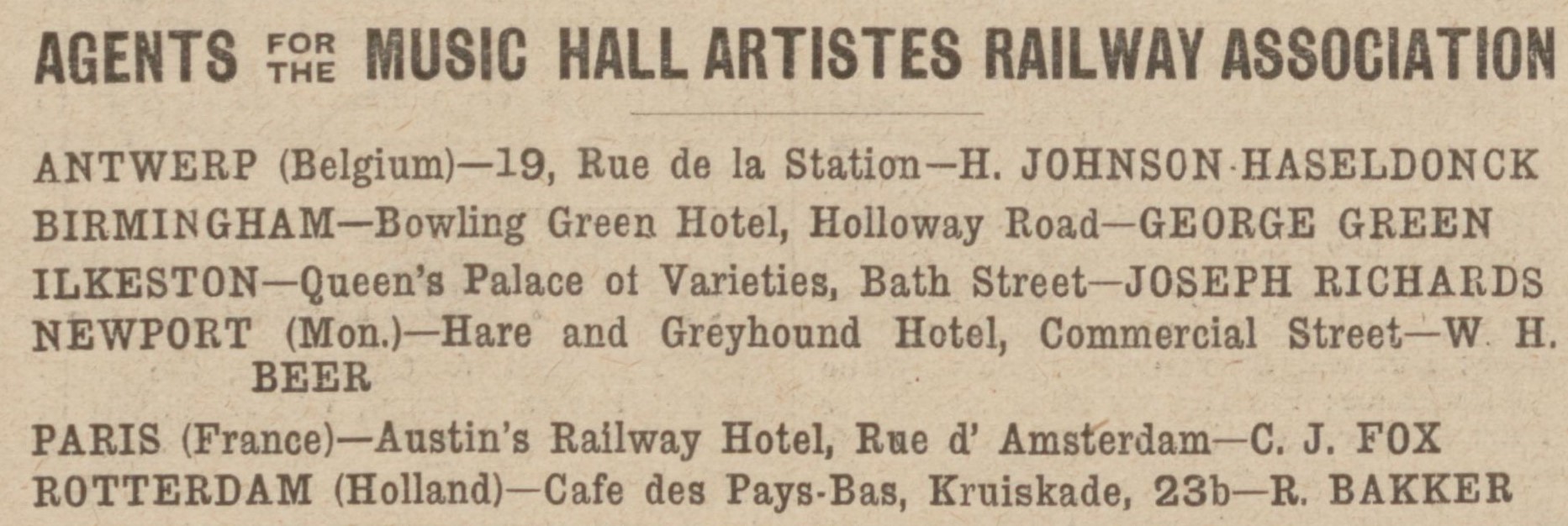After The Allcock sisters Adeline takes us to “the Queen’s Head Inn which was an old house and stood back on the top of a long slope. Its rooms were low and dark”.
This was 103 Bath Street in 1871 and 1881. As you look at the map below you will see how the Inn stood back from the road, and note the location of Bostock’s Row … the significance of this to be explained on the next page.
Landlord Benjamin Wade
Before Aaron Aldred arrived as landlord of the Queen’s Head about 1843, it was in the hands of Ilkeston builder Benjamin Wade. who was certainly there as landlord in 1819, being described as such in the annual Carnation and Gooseberry Show at the Green Dragon, St. Peter’s Gate, Derby on August 7th of that year.
Benjamin Wade was the son of builder/mason Robert and Mary (nee Milward) … Robert being the builder responsible for the houses in Flinders’ Row, just round the corner in Chapel Street. Benjamin was married to Mary Haseldine of Cossall on August 7th, 1805
In April 1837 the Duke of Rutland presented to the cricket club, whose meetings were held at the Queen’s Head, a piece of ground to play their matches. It was to be known as “Granby Park”.
On March 15th, 1842 Benjamin senior found himself in the criminal court at Derby, flanked by two of his sons, Robert and George, charged with the manslaughter of cordwainer James Smith of Chapel Street in October 1841. On Saturday night, October 16th, James Smith and his brother William had been out on the town, conducting “club business” but also downing a few strong ales at the same time. As they were returning home they called in at the Queen’s Head for a last drink with relatives, by which time they were both drunk. Somehow James became engaged in an argument with Robert Wade, Benjamin’s oldest son, over the issue of dahlias (not carnations) !! Both took off their coats, ready to go “ten rounds” when Robert’s mother, Mary Wade, stepped between them to stop any fighting. Her gesture was futile however and a scuffle ensued which widened to include both Smiths, Robert Wade and his father Benjamin. At this point George Wade walked into the room, dressed in only shirt and trousers, having just got out of bed. Immediately he came to the defence of his father and attacked James. The latter was struck and fell back, his head striking either a chair or the floor (depending upon which witness was testifying) and then lying lifeless on the floor — so it seemed. Nevertheless Dr. George Lucas was summoned but he confirmed the fears of James’s mates … the cordwainer was dead. A subsequent post mortem examination revealed the cause of death was damage to the brain caused by an external blow … and George and his kin were thus arrested, to stand trial for manslaughter.
The case against the Wades was not strong (at least not strong enough for the jury at the subsequent trial in March 1842) and “after two or three minutes’ deliberation” the trio were acquitted of “killing and slaying” James. The fact that the cordwainer was drunk seems to have counted in the Wade’s favour.
James Smith was the first cousin once removed of Joseph Smith whose murder occurred almost 20 years later and a few doors away.
Apart from the two sons Robert and George, Benjamin and Mary had nine other children.
Their eldest child Ann was baptised in January 1806, and married John Ross on May 22nd, 1832. A younger son George was born in 1818. Both these Wade children are mentioned in a letter written by John Cartwright in 1893 (IP).
“Brother John Ross, grocer and local preacher” is correctly described as “a gentleman by nature, and as a great Radical orator”. He was a clever, many-sided man, who could turn his hand to many things; and late in life he embraced the profession of auctioneer, and practised it in Nottingham. He married Miss (Ann) Wade, sister to Mr. George Wade, who died at another sister’s (Mary’s) residence in Ilkeston (at 161 Station Road) only two or three weeks since, and respecting whose successful career in Sheffield you published an interesting paragraph at the time. I well remember Mr. George Wade’s occasional visits to his native town when I was a lad, and can vividly call to mind his appearance in those far away days.
In 1847 Ann’s husband, John Ross, then a grocer, hosier and draper trading in his shop at the bottom of Bath Street, was in financial difficulty and declared bankrupt. In the following year his premises were put up for auction
The Sheffield Independent (May 9th 1893) records the death of the son, George …
Mr. George Wade, formerly a well-known builder and contractor in Sheffield, died on Saturday (May 6th) at Ilkeston. After giving up business in Sheffield he went to reside at Southport, where his wife died two or three years ago. He was shortly afterwards seized with paralysis, and has since then been in failing health. Mr. Wade came here upwards of fifty years ago, and soon succeeded in taking a prominent position in the building trade. Amongst the work he did was the erection of the new banqueting room at the Cutlers’ Hall, the Norfolk Drill Hall, the brick work of the Norfolk Market Hall and the Victoria Station, the Roman Catholic Schools in Queen’s-road, and the offices of the then Water Company in Division-street. He was largely employed upon work for the Duke of Norfolk. Mr. Wade, who was in his 79th year, had no family. Madam Vadini, a lady known upon the operatic stage, was his adopted daughter (Emily Wade)
The adopted daughter ‘Madame Vadini‘ was born Emily Whitaker in 1860 in Sheffield, the daughter of John Johnson Whitaker and his wife Mary (Bradbury), who died shortly after the birth. John Johnson Whitaker then remarried, to Hannah Keeton in 1862; Hannah was the sister of Mary Keeton, who in 1853 had married George Wade.
John Johnson Whitaker died in the year following his second marriage, leaving wife Hannah with several children from his first marriage.
This is how Emily Whitaker became the adopted daughter of George and Mary Wade (nee Keeton) and adopted the name of Emily Whitaker Wade (alias Madame Vadini !!
Very shortly after the Wade’s acquittal for the killing of James Smith (and at least by August 1842) the inn was in the hands of William Moreland who was the second husband of Benjamin Wade’s daughter, Sarah. And, by the end of 1842, had recent events taken their toll ? In December, Benjamin had assigned all his personal effects and estate for the use of his creditors. This included three freehold properties, recently built by Benjamin in Wheatley Croft (aka Lee’s Croft), just to the east of the Queen’s Head Inn.
Something of a puzzle here ?
The advert (right) is taken from the Ilkeston Pioneer, December 10th 1857
It seems to refer to Benjamin Wade junior (1826-1876). He moved to Belper in the 1840s and while there, trading as a grocer, married Eliza Beeston on December 4th 1848 at Brailsford.
For the rest of his life he either worked as a grocer/provision dealer or was retired, and stayed at Belper, and later at Heage nearby.
He is mentioned in several trade directories as having an establishment in Bath Street, Ilkeston.
At the very end of his life Benjamin junior moved back to Ilkeston and died on December 10th 1876, aged 49.
And why was this shop called ‘the Hyson Chest’ ?
Is it a reference to this warehouse in Friar Lane, Nottingham, just opened about 1830 and featured in the Nottingham Review and General Advertiser (November 5th, 1830) ?
—————————————————————————————————————————————————————
Landlord Aaron Aldred
(After Benjamin) “the landlord, who had one daughter and two sons, was Mr. Aaron Aldred.”
Brinsley-born Aaron Aldred was a son of collier Samuel and Mary (nee Ottewell), one of their at least ten children, and came to the Queen‘s Head Inn about 1843, taking over from Benjamin Wade, and the brief proprietorship of William Moreland. His first wife was Maria Potter whom he married in April 1836 and with whom he had six children. She died in August 1850 and six months later Aaron married Catherine Forman who bore him two further sons, Aaron junior and Arthur.
At the end of October in 1854 horse-breaker Charles Hampson popped into the Queen’s Head to call on a friend. He was persuaded to stay and became engaged in a competitive game or two of bagatelle, at the end of which he was three quarts of ale better off. Other customers, perhaps sore losers, objected to Charles downing his winnings and a jug of ale was subsequently propelled in his direction, missed its target and broke a screen. The commotion alerted landlord Aaron who intervened and seems to have impounded Charles’ hat as payment for the damage which he blamed on the horse-breaker. His actions however landed Aaron in court where he was fined for assaulting Charles and breaking the brim of his hat. Not only that but in a follow-up case he was fined for allowing gaming on his premises, contrary to his licence. Aaron didn’t realise that merely playing for ale was equivalent to gaming and for this ignorance his fine was reduced.
The children of Aaron Aldred
First marriage
Born on April 7th, 1837 the eldest child was William who died on July 21st, 1840.
Angelina was the eldest daughter, born on June 9th, 1839 and who, on August 25th, 1856 married brewer William Barker, later to be the keeper of the Commercial Inn on Awsworth Road. Angelina died there on January 24th, 1874.
It was Aaron’s second daughter Juliana (born on June 8th, 1841) who on August 1st, 1866 married maltster Thomas Attenborough Beardsley.
As Adeline Wells recalls “his daughter married Tom, the eldest son of Isaac Attenborough, of the Sir John Warren Inn, in the Market Place.”
He was the illegitimate son of Sarah Beardsley who on April 7th, 1850 had married Isaac Attenborough, seven years after the birth of Thomas. Isaac was the son of Mark, proprietor of the Sir John Warren Inn in the Market Place.
(The 1841 census shows a Sarah Beardsley as a female servant at this inn).
After a few years farming at Locko Grange near Dale Abbey, they returned to keep the Horse and Groom Inn at Gallows Inn on Nottingham Road, where Juliana died on August 27th, 1876, aged 35.
Maria, born on February 21st, 1844, died in infancy … on March 22nd, 1844.
Born on January 17th, 1845 Elvina married grocer’s assistant Luke Wright on December 5th, 1862, but died six years and three children later, aged 24 … on February 19th, 1869
Victoria, born on July 11th, 1847 died eight weeks later, on September 7th.
There were no more children … !!
from the Nottingham and Newark Mercury (January 21st, 1848)
Maria died on August 30th, 1850, aged 35.
—————————————————————————————————————————————————————
Second marriage.
Aaron senior married Catherine Forman on February 10th, 1851.
As Adelie tell us “Aaron the eldest son, married Sabina, third daughter of John Gregory, pit contractor, Burr Lane.”
Aaron junior married Sabina Gregory, the fourth daughter of Burr Lane ironstone contractor John and Ann (nee Parkin) in October 1875. The couple lived at the Inn — where ‘junior’ was to replace ‘senior’ as landlord in July 1881 — but their marriage was not a happy one.
About six months after the marriage Aaron junior began to physically abuse Sabina and this cruelty continued for several years, during which time six children were born though none lived beyond infancy. The wife was constantly verbally assaulted, was knocked to the ground, partially strangled, doused with water, struck in the face, had whiskey thrown in her eyes, and was locked out of the house.
In Aaron’s eyes however, his wife was no angel and he charged that she was often ‘beastly drunk’, openly used bad language, and was very belligerent.
In 1882 Sabina discovered her husband’s adultery with a barmaid — though he didn’t try hard to conceal it — and shortly after she petitioned for a dissolution of her marriage. The suit was undefended and the petition granted in the Probate and Divorce Division of the High Court of Justice in June 1883.
The 1891 census shows Sabina now using her maiden name and living with her widowed mother in North Street.
She continues … “Joseph (?) married Zillah Wheeldon, from near the Toll Gate.”
It was Arthur Aldred, not Joseph, who married Zillah Wheeldon, daughter of lacemaker William and Mary (nee Birkin) in 1875. She worked at Carrier’s Hosiery factory, earning 12s or 13s a week, and was lodging with her sister Olinda and Moses Tilson, her sister’s husband. Arthur and Zilla were ‘together‘ for about three or four years before he ‘got her into trouble‘, the result of which was Arthur William Wheeldon, born on December 22nd, 1874. Arthur then paid 5s per week to help support the child, before they married — in 1875, at Babbington Chapel near Awsworth.
For a few years they lived at the Queen’s Head, owned by Arthur’s father, but about 1883 Arthur became landlord at the General Havelock in Stanton Road. It was at that Inn that Zillah gave birth to their son Herbert Aldred on August 6th 1887. However this marriage was also unhappy — the couple had separated on several prior occasions and now Arthur forcibly ejected Zillah from the home, and she was later reunited, at a friend’s house, with baby Herbert (He died eight months later, on April 2nd 1888, at 50 North Street)
In November of 1887 Arthur sued his wife for an account of £36 10s, held by his wife in her name — and without his knowledge or consent — at the Nottingham Joint Stock Bank. The solicitor representing Arthur quoted the Married Women’s Property Act of 1882 which allowed married women to hold an account at a bank, separate from her husband but using money given to her by her husband, that account to be regarded as her own property … but only if her husband knew of the account and consented !! Arthur argued that Zilla must have accumulated the money from his income without him knowing — she had no other source of income and she never told him that she had saved anything. However Zilla asserted that, before her marriage, she was able to save money out of her wages and out of the money Arthur gave her, So, by the time they married she had saved up about £20, which, she claimed, Arthur knew about.
Eventually the arguments resulted in an agreement to divide the money between the two parties.
And then the issue of maintenance reared its head !!! Zillah claimed that she had been deserted by Arthur. He did not contest this and ended up paying 12s 6d per week for Zillah and Herbert. The latter died on April 2nd 1888 and shortly thereafter, Arthur’s solicitor was back to the court, attempting to reduce the weekly maintenance. It was reduced — to 10s per week — although Arthur now found himself with a bill for £2 3s 6d, as part-payment for Herbert’s funeral expenses.
In March,1896, because of Arthur’s increased income, the maintenance order was also increased — to £1 a week.
You may be comforted to know that a few years after the separation, Arthur had found contentment in the company of Elizabeth Fogg, daughter of carpenter William and Alice (nee Holden). From at least 1891 she can be found living with Arthur, at first in Chapel Street, and was with him as they moved to Arnold, Nottingham by the end of the century. In 1926 Zillah died, also in Nottingham and thus Arthur was free to marry Elizabeth (I am assuming the Aldreds had not divorced). Arthur and Elizabeth did marry later that same year.
Arthur died on December 7th, 1933 at 52 Hood Street in Nottingham, aged 79. I believe Elizabeth died in 1940, also in Nottingham.
I lost track of Zillah after the maintenance order of 1896.
—————————————————————————————————————————————————————
Landlord John Trueman
In December 1882 the Queen’s Head Inn was sold at auction to John Trueman, formerly of the Durham Ox, for £3220. (This was the time that Arthur Aldred left to become landlord of the General Havelock in Stanton Road).
A few months later — and without waiting for the plans to be approved by the Local Board — John began his ‘improvements’.
Discretely sheltered behind a new wall, a urinal and ashpit in front of the inn and facing out towards Bath Street were erected without authoritative approval — though ‘the Board did not feel inclined to assert its power’ and ordered him to pull it down. This would be just a few years after the map at the top of the page was drawn — I leave you to work out where the ‘improvements‘ would be positioned !!
John described his addition as ‘a storeroom’!! ‘For the sake of gratifying curiosity the Highways Committee might .. take a look in and let us know what kind of ‘stores’ are kept in this potential nuisance’. (IA Oct 1883)
Wright’s Directory of 1885 shows the Inn occupied by William Vincent Barnett but in 1885 it was transferred to George B. Marples. In February 1886 the Inn was advertised as ‘to let‘, recently enlarged and improved. And in December 1886 the licence was transferred to John Trueman who then began yet more improvements !!
By July of 1888 John had just completed a new building adjacent to the previous Queen’s Head Inn (see photo below) and now had scaffolding erected at the front of both buildings. On top of this, three stories up, was stonemason Edward Smith, fixing coping stones on the fascade (to make the new building blend with the old), when the scaffolding gave way and completely collapsed. Down came Edward plus the stone he was working with — and which landed on his head. Unconscious, he was taken to the Cottage Hospital with a fractured skull and ribs, a broken arm and contusions all over his body. “His condition was so serious that the gravest fears are entertained”. Edward was a powerfully built fellow however, and under the care of Dr Henry Potter and matron Miss Dean, he quickly rallied. (And have no fear … Edward appears on the 1891 census, living in Taylor Street).
And here, below, is the site in later years; by now it had been renumbered as 48.
In March 1896 the licence was transferred from John Trueman to Mary Ann Lawrence, and then, at the end of March 1897 she relinquished it to Joseph ‘Joe’ Richards.
March 1899: Joseph keeps illustrious company (The Music Hall and Theatre Review)
—————————————————————————————————————————————————————
Accident Alert !! Noon on Saturday, September 24th, 1898.
Arthur Rowland of Church Street was driving a heavy coal dray belonging to coal merchant Joseph Shorthose, also of Church Street, slowly down Bath Street. Struggling to keep hold of his horse as he descended the steep hill, young Arthur got as far as the Queen’s Head hotel where he lost complete control and ‘bailed out’. He jumped clear of the dray only to watch it thunderously disappear into the distance, towards the Poplar Inn. At that point it overtook two other horses and carts belonging to and attended by George Henry Morral, hay and milk dealer of Barker Gate. Both his carts and horses were pitched over as the coal dray hit them, one of the horses landing firmly on top of him. Marvellously George Henry escaped serious injury. The horse dragging the coal cart now broke loose and was about to race off when it was tackled by P.C. Wooley and gallantly brought under control.
All three carts suffered minor damage while the three horses escaped with a few cuts.
—————————————————————————————————————————————————————
Next came Bostock’s Row and the rowing Bostocks were the nemeses of landlord Aaron.

